PREPARING YOUR GARDEN FOR WINTER
Summer’s almost over, the days are getting shorter and the evenings are getting cool. Now is a great
time to start getting your landscape ready for its long winter sleep and to prepare for a burst of spring
colour. Fall is an excellent season for gardening, and here are a few things that you can do right now to
get your landscaping ready for next year. The work you do right now will help your lawn and gardens
look beautiful next season.
PLANT TREES AND SHRUBS
Fall is a great time to plant trees and shrubs. The root systems grow well in the warm soil but foliage
growth slows down at this time of year. If you plant now, root systems will be well established before
next summer’s heat. Just be sure to keep new trees and shrubs well watered to prevent them from
drying out. It’s also very important to give them a good soak before the frost settles in.
Most trees and shrubs can be pruned now. Branches that are crossed and rubbing against each other
should be removed, as well as those infected with black knot. Make sure to destroy black knot infected
branches by putting them in a black garbage bag for the landfill. Do not put them in your green bin or
compost pile. Make sure to clean your pruning tools when you are done removing the diseased
branches.
PLANT BULBS AND GARLIC
Fall is the season for planting new bulbs. They’ll lie dormant over the winter and once the ground starts
to warm up in the spring, you’ll be treated to an early season burst of blooms in your garden. Some
popular bulbs to choose from this time of year are Prairie Crocus, Alliums, Daffodils and tulips.
In Calgary, garlic cloves are planted the last couple of weeks of September, the first part of October
depending on the weather. The cloves need a few weeks to put down roots and develop clove buds
before the ground freezes. Garlic planted in the fall will be ready to harvest in the spring.
KEEP YOUR LEAVES
If you have trees that drop leaves in the fall you have a ready and free supply of mulch for your beds.
Rake up your leaves and run over them with your lawnmower. If you have a leaf vacuum that grinds
them up that’s even better. When leaf mulch is raked onto flower beds, it breaks down quickly and
provides much needed nutrients. The extra layer of protection also makes it easier for plants to survive
over the winter months.
LAWN CARE
Your lawn takes a beating during the hot, dry days of summer. There are a few tips you should follow
when preparing your lawn for winter. Mow grass to a height of 2-1/2 inches and leave clippings on the
lawn. This simple step returns at least 25% of the turf's nitrogen back to the soil. Moisten and aerate the
lawn. Aeration creates passageways for essential nutrients and worms that contribute valuable
microorganisms to your soil. Overseed now for a thicker healthier lawn in spring. Finally, fertilize the
lawn. Fall fertilizing gives your lawn the nutrients it needs to stay healthy. Winter care lawn fertilizers
energizes turf, producing a strong and healthy root system and ensuring it emerges greener than ever
when spring arrives.
ANNUALS AND PERENNIALS
If your pots are getting tired looking and you want to enjoy one last pop of colour you can replace
summer flowers with fall mums. Also, now is the perfect time to plant hardy perennials, many are
available at garden centers and big box stores.
Which perennials to leave until spring and which to cut back are a matter of personal choice. I choose to
leave perennial grasses for winter interest, these should be cut back in the spring before the new
growth starts. I usually leave my perennials in the garden to collect snow this creates an insulator and
helps with our chinook freeze/thaw cycle that we enjoy so much in the winter months.
Lastly, a deep watering of perennials, shrubs and trees will produce welcome results next spring and
summer.
If you have any questions please contact [email protected]


